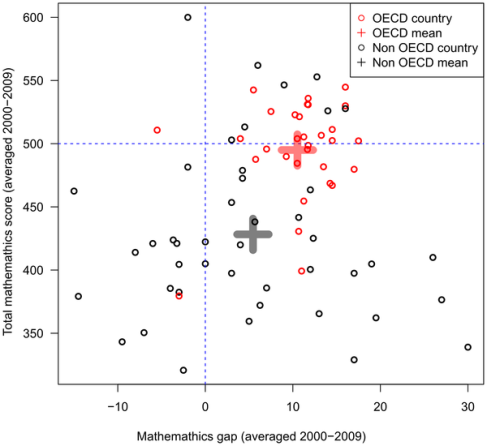Here are some basic facts about the gender gaps in mathematics and reading
Note: Sources+links at bottom
About the mathematics gender gap:
- 15-year old boys are better than girls in mathematics (period: 2000-2009).
- This is true for most countries, although there are countries in which there is no difference between boys and girls, and even a few countries in which girls outperform boys (see below)
- Unlike what many people think, the degree to which boys outperform girls in mathematics is unrelated to gender equality.
- The gender gap in mathematics is larger in the rich OECD countries than in the poorer non-OECD countries (note OECD is a cooperation of economically developed countries)
- Among the poorest performing school children, the gender gap is non-existent or very small.
- Among the best performing school children, the gender gap is large.
- There are two high performing boys for every high performing girl.
About the reading gender gap:
- 15-old girls are better than boys in the understanding of text. This is known as the gender achievement gap in reading.
- This reading gap is 3x larger than the mathematics gender gap.
- This is found in all countries, even though there is variation between countries.
- Countries with a small mathematics gender gap have a larger reading gap. These two gaps are inversely related to one another.
- The reading gap is growing.
- The reading gap is largest among the poorest performing children.
A couple of things are really surprising in this study:
- The mathematics gender gap is not closing as some researchers have been claiming.
- The mathematics gender gap is not related to gender equality policies.
- The gender gap in mathematics is particularly large in modern well developed countries, such as most Western countries.
- The top 3 countries in which girls do better than boys in mathematics are:
- Malta
- Albania
- Qatar
These countries are typically not taken as models of gender equality policies.
- Countries that are often taken as leaders in gender equality and women’s education, such as the Scandinavian countries have large gender gaps in reading, that is, boys do particularly bad compared to girls.
The bottom line: Gender gaps in school performance continue to exist. Equality policies seem irrelevant for closing the gap. No country has managed to overcome gender gaps, and more research is necessary to find out what exactly is going on.
Links to the study:
- Read the original study by Stoet and Geary in PloS ONE
- Watch a short YouTube film about this study
- Read the University of Missouri press release
- Read the University of Leeds press release
- A complete list of countries and the mathematics and reading gaps
- Programme for International Student Assessment


Why is your research on these “gender gaps” limited to 15-year-old students? What is the situation among 9-year-olds, and among 25-year-olds? (Isn’t there some evidence that the human brain is still plastic and developing until about 25?) Is there evidence that the “third gender category” exhibits different gaps? It just appears to me that you may have cherry-picked a particular time in adolescent development during which the gender gap supports your preconceived notions and bias. Just saying. I don’t claim to be a psych researcher; I’m just a little old lady retired high school teacher.
The reason is that the large database we analyzed uses 15 year olds. We analysed the PISA data set, the worlds largest international study evaluation educational outcomes. 15 years is the highest age at which education is compulsory in most countries around the world.
Excellent article. Very interesting indeed. Do you reckon there’s any neglect of boys’ education in countries where the gener gap in mathematics is reduced and the language gar is widened?.
This article is inaccurate.
The methodology used for measuring gender inequality is flawed, it goes by a “nations’ gender equality indicators”…which doesn’t include things like what women are interested in.
Studies show that women aren’t interested in mathematics because of romance and love…”women don’t just like math less when they are focused on love – they also do less math” – https://www.psychologytoday.com/blog/the-science-success/201109/how-wanting-love-makes-girls-bad-math
The reason why there’s a gap is because women aren’t interested in being good at mathematics, there’s probably a higher number of females interested in being playboy models than there are females interested in being good at mathematics.
When it comes to like the number of female models, porn stars, prostitutes, strippers, etc…there’s a big gap with more females…but does that mean females are better at that than males or just more interested in doing those things?